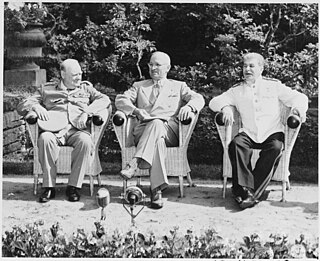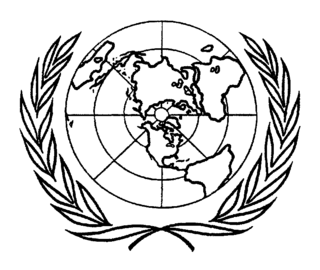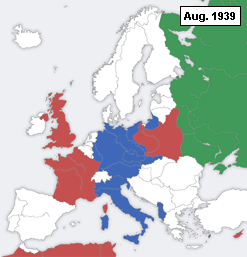
The Potsdam Conference was held at Potsdam in the Soviet occupation zone from July 17 to August 2, 1945, to allow the three leading Allies to plan the postwar peace, while avoiding the mistakes of the Paris Peace Conference of 1919. The participants were the Soviet Union, the United Kingdom, and the United States. They were represented respectively by General Secretary Joseph Stalin, Prime Ministers Winston Churchill and Clement Attlee, and President Harry S. Truman. They gathered to decide how to administer Germany, which had agreed to an unconditional surrender nine weeks earlier. The goals of the conference also included establishing the postwar order, solving issues on the peace treaty, and countering the effects of the war.

The Tehran Conference was a strategy meeting of the Allies of World War II, held between Joseph Stalin, Franklin D. Roosevelt, and Winston Churchill from 28 November to 1 December 1943. It was the first of the Allied World War II conferences involving the "Big Three" and took place at the Soviet embassy in Tehran just over a year after the Anglo-Soviet invasion of Iran. The meeting occurred shortly after the Cairo Conference was held in Egypt for a discussion between the United States, the United Kingdom, and China from 22 to 26 November 1943. The Big Three would not meet again until 1945, when the Yalta Conference was held in Crimea from 4 to 11 February and the Potsdam Conference was held in Allied-occupied Germany from 17 July to August 2.

The Yalta Conference, held 4–11 February 1945, was the World War II meeting of the heads of government of the United States, the United Kingdom and the Soviet Union to discuss the postwar reorganization of Germany and Europe. The three states were represented by President Franklin D. Roosevelt, Prime Minister Winston Churchill, and General Secretary Joseph Stalin. The conference was held near Yalta in Crimea, Soviet Union, within the Livadia, Yusupov, and Vorontsov palaces.

The Bretton Woods Conference, formally known as the United Nations Monetary and Financial Conference, was the gathering of 730 delegates from all 44 allied nations at the Mount Washington Hotel, in Bretton Woods, New Hampshire, United States, to regulate what would be the international monetary and financial order after the conclusion of World War II.

The Hague Conventions of 1899 and 1907 are a series of international treaties and declarations negotiated at two international peace conferences at The Hague in the Netherlands. Along with the Geneva Conventions, the Hague Conventions were among the first formal statements of the laws of war and war crimes in the body of secular international law. A third conference was planned for 1914 and later rescheduled for 1915, but it did not take place because of the start of World War I.

The Casablanca Conference or Anfa Conference was held in Casablanca, French Morocco, from January 14 to 24, 1943, to plan the Allied European strategy for the next phase of World War II. The main discussions were between US President Franklin Roosevelt and British Prime Minister Winston Churchill. Stalin could not attend. Key decisions included a commitment to demand Axis powers' unconditional surrender; plans for an invasion of Sicily and Italy before the main invasion of France; an intensified strategic bombing campaign against Germany; and approval of a US Navy plan to advance on Japan through the central Pacific and the Philippines. The last item authorized the island-hopping campaign in the Pacific, which shortened the war. Of all the decisions made, the most important was the Allied invasion of Sicily, which Churchill pushed for in part to divert American attention from opening a second front in France in 1943, a move that he feared would result in very high Allied casualties and not be possible until 1944.

The Declaration by United Nations was the main treaty that formalized the Allies of World War II and was signed by 47 national governments between 1942 and 1945. On 1 January 1942, during the Arcadia Conference in Washington D.C., the Allied "Big Four"—the United States, the United Kingdom, the Soviet Union, and China—signed a short document which later came to be known as the United Nations Declaration, and the next day the representatives of 22 other nations added their signatures.

The Allies, formally referred to as the United Nations from 1942, were an international military coalition formed during World War II (1939–1945) to oppose the Axis powers. Its principal members by the end of 1941 were the "Big Four" – the United Kingdom, United States, Soviet Union, and China.

In the Empire of Japan, an Imperial Conference was an extraconstitutional conference on foreign matters of grave national importance that was convened by the government in the presence of the Emperor.

The Third Moscow Conference between the major Allies of World War II took place during October 18 to November 11, 1943, at the Moscow Kremlin and Spiridonovka Palace. It was composed of major diplomats, ministers and generals, who discussed cooperation in the war effort, and issued the Moscow Declaration.

The Second Quebec Conference was a high-level military conference held during World War II by the British and American governments. The conference was held in Quebec City, September 12 – September 16, 1944, and was the second conference to be held in Quebec, after "QUADRANT" in August 1943. The chief representatives were Winston Churchill, Franklin D. Roosevelt and the Combined Chiefs of Staff. Canada's Prime Minister William Lyon Mackenzie King was the host but did not attend the key meetings.

The United Nations Conference on International Organization (UNCIO), commonly known as the San Francisco Conference, was a convention of delegates from 50 Allied nations that took place from 25 April 1945 to 26 June 1945 in San Francisco, California, United States. At this convention, the delegates reviewed and rewrote the Dumbarton Oaks agreements of the previous year. The convention resulted in the creation of the United Nations Charter, which was opened for signature on 26 June, the last day of the conference. The conference was held at various locations, primarily the War Memorial Opera House, with the Charter being signed on 26 June at the Herbst Theatre in the Veterans Building, part of the Civic Center. A square adjacent to the Civic Center, called "UN Plaza", commemorates the conference.

The Third Washington Conference was held in Washington, D.C from May 12 to May 25, 1943. It was a World War II strategic meeting between the heads of government of the United Kingdom and the United States. It was the third conference of the 20th century, but the second conference that took place during the US involvement in the Second World War. The delegations were headed by Winston Churchill and Franklin D. Roosevelt, respectively.
This is a list of World War II-related topic lists:

The Abilene Christian Wildcats football program is the intercollegiate American football team for the Abilene Christian University located in the U.S. state of Texas. The team was a member of the Southland Conference through the 2020–21 season, but joined the Western Athletic Conference in July 2021, coinciding with that league's reinstatement of football as an official conference sport. After the 2022 season, the WAC fully merged its football league with that of the ASUN Conference, creating what eventually became the United Athletic Conference, and ACU accordingly moved its football team to the new league. The school's first football team was fielded in 1919. The team plays its home games at the on-campus Anthony Field at Wildcat Stadium.

This is a timeline of declarations of war during World War II.
The Declaration of St James's Palace, or London Declaration, was the first joint statement of goals and principles by the Allied Powers during World War II. The declaration was issued after the first Inter-Allied Conference at St James's Palace in London on 12 June 1941. Representatives of the United Kingdom, the four co-belligerent Commonwealth Dominions, the eight governments in exile and Free France were parties to the declaration. It stated the Allies' commitment to continue the war against the Axis Powers and established principles to serve as the basis of a future peace.













